Balance your living space with Feng Shui design principles for a harmonious and prosperous environment, discover how in our enlightening guide.
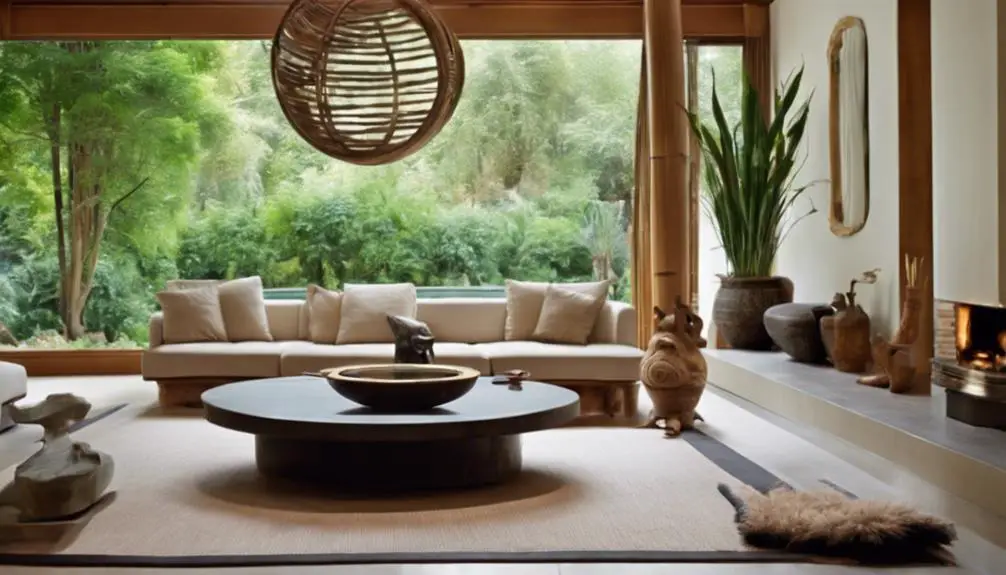
Feng Shui Design Principles
Imagine for a moment, you're in the era of Ming Dynasty, arranging your living space with ancient wisdom that promises harmony and prosperity. That's Feng Shui for you, a timeless design principle from the Orient.
You might ask, how can this ancient art be relevant in today's modern world? Well, it's about balance, energy, and positivity – concepts as pertinent today as they were centuries ago.
But how do these elements interplay to create a space that exudes positivity and well-being? We're just getting started on that.
Key Takeaways
- Feng Shui centers around the flow of Chi or life force, impacting health and prosperity.
- The five elements (Wood, Fire, Earth, Metal, and Water) are vital for elemental balance in Feng Shui.
- Bagua, serving as an energy compass, guides the energy flow and represents life aspects for tranquility.
- Practical Feng Shui design involves color representation, spatial arrangement, clear pathways, and balanced furniture for positivity and productivity.
Understanding the Concept of Chi
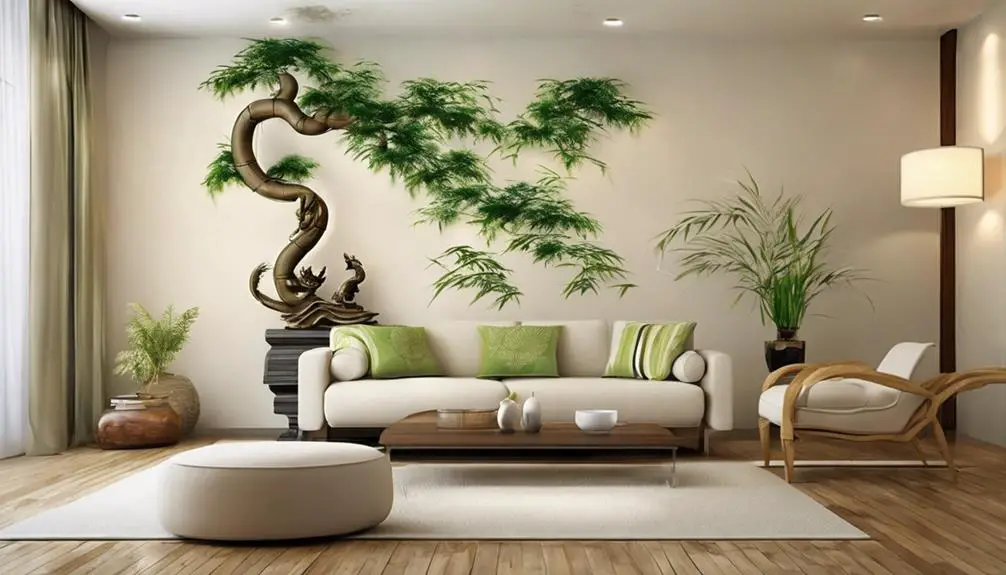
Delving into the world of Feng Shui, you'll first need to grasp the ethereal concept of 'Chi', the life force that ebbs and flows in every living thing, shaping our lives and surroundings. Picture it as a gentle river, coursing through the landscape of your life. When the flow is uninterrupted and harmonious, it fosters health, prosperity, and happiness. Conversely, blocked or stagnant Chi can lead to misfortune and ill health.
Understanding Chi flow techniques is akin to learning the choreography of the universe. You're not just decorating a room; you're facilitating the dance of energy around you. Think of your living space as a canvas where Chi is the invisible paint, and Feng Shui is the brush guiding its movement. Properly applied, these techniques can bring balance, serenity, and vitality to your life.
Chi and health are intricately woven together. Your physical, emotional, and spiritual health are all influenced by the Chi in your environment. Imagine it as a nourishing breeze, its invisible touch bringing a sense of calm, rejuvenation, and vitality. By understanding and harnessing Chi, you're not merely surviving, but truly living.
The Five Elements of Feng Shui
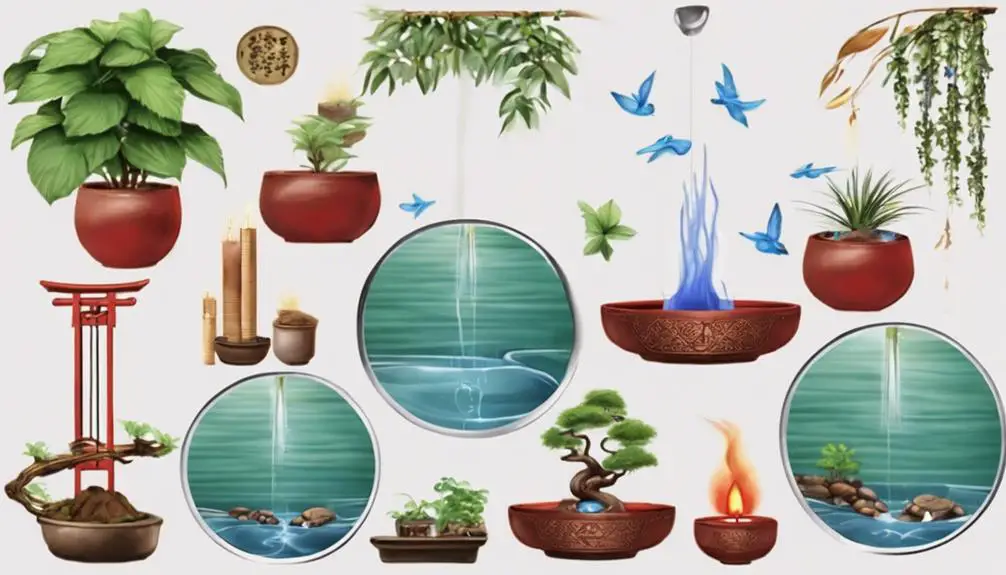
Stepping into the heart of Feng Shui, you'll encounter the powerful dance of the Five Elements – Wood, Fire, Earth, Metal, and Water, each one resonating with distinct energies and interwoven relationships that shape the world around us. They spin a tapestry of balance and harmony, intricately connected to the Yin Yang Integration, the universal balance of dark and light, negative and positive.
| Element | Associated Energy | Interplay with Yin Yang |
|---|---|---|
| Wood | Growth, Vitality | Yang, Active, Expansive |
| Fire | Passion, Warmth | Yang, Active, Transformative |
| Earth | Stability, Nourishment | Yin, Passive, Grounding |
| Metal | Order, Discipline | Yin, Passive, Contracting |
| Water | Wisdom, Healing | Yin, Passive, Adapting |
Delving deeper, you'll understand how these elements interact, creating an Elemental Balance. Wood fuels Fire, Fire creates Earth (ash), Earth bears Metal, Metal collects Water, and Water nourishes Wood. But, they also control each other: Wood parts Earth, Earth absorbs Water, Water quenches Fire, Fire melts Metal, and Metal chops Wood.
Understanding the dance of these elements is a key step in mastering Feng Shui. It's not just about arranging furniture; it's about creating a living, breathing ecosystem that nurtures your soul and invigorates your life.
Importance of Bagua in Feng Shui
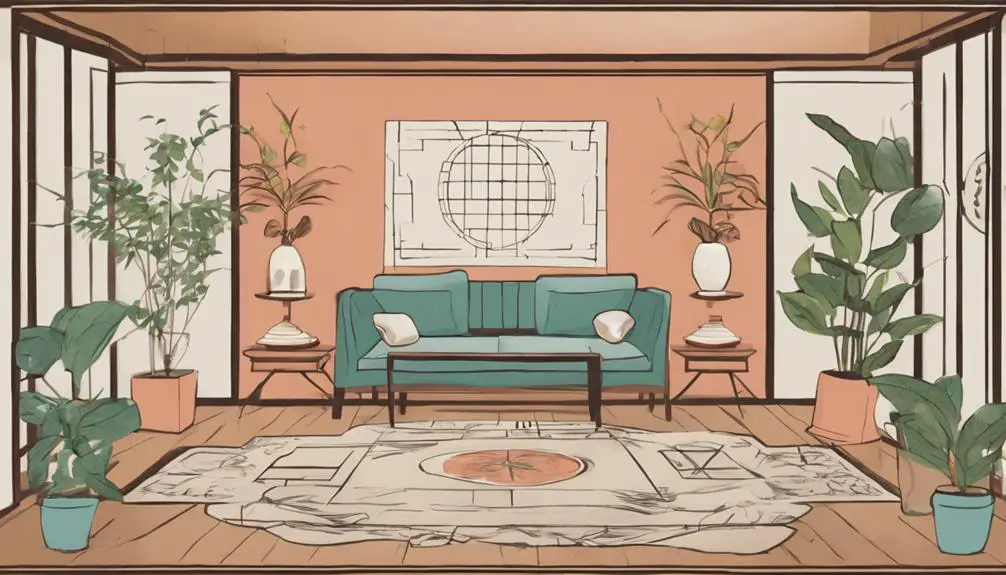
Just as understanding the interplay of the Five Elements is crucial, so too is mastering the Bagua, an essential tool in Feng Shui that exerts profound influence over your environment's energy flow.
Delve into the intricate world of Bagua symbolism, and you'll find it's like a compass, guiding the natural flow of energy, or Qi, within your living space.
Each of the eight sectors of the Bagua map represents a different aspect of life, from career to family, wealth to wisdom. It's not just about placing objects haphazardly. It's about understanding the energy they represent and how they interact with your space. Bagua applications are as diverse as the spaces they adorn. You might use it to design your home, office, even your garden.
Imagine your space as a canvas, and Bagua as your palette. With each stroke, you're not merely decorating; you're creating an energetic masterpiece. You're orchestrating a symphony of colors, materials, and objects, each playing a specific note in your harmonious life-scape.
Mastering Bagua isn't just about design; it's about living in harmony with your surroundings. It's about creating your own personalized haven of balance and tranquility.
Practical Feng Shui Design Tips
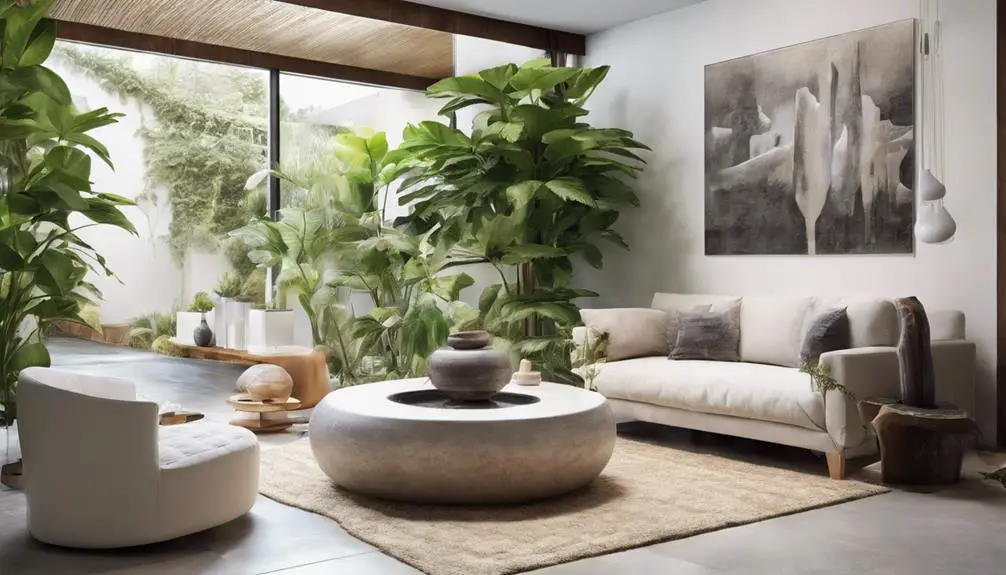
With a well-crafted Bagua map as your guide, you're now ready to embark on the journey of transforming your living space with practical Feng Shui design tips. Let's delve into two key elements: Color Implications and Spatial Arrangement.
Color holds a significant place in Feng Shui. It's not just about aesthetics; it plays a crucial role in balancing energy. Each color represents a specific element and can influence mood and emotions.
Spatial Arrangement, on the other hand, is about organizing your space to allow free-flowing energy. It's the art of positioning your furniture and accessories in a way that promotes harmony and positivity.
Here's a handy table to guide you:
| Colors | Elements | Mood |
|---|---|---|
| Red | Fire | Stimulates |
| Blue | Water | Calms |
| Green | Wood | Balances |
| Yellow | Earth | Nurtures |
| White | Metal | Purifies |
| Spatial Arrangement | Purpose | Effect |
| Clear Pathways | Uninterrupted Energy Flow | Reduces Stress |
| Balanced Furniture | Harmonious Environment | Boosts Productivity |
| Decluttered Space | Positive Energy | Enhances Mood |
With these tips, you're not just designing your space; you're creating an oasis of positive energy and harmony. Embrace this journey and watch your home transform.
Harnessing Feng Shui for Positivity

As you harness the power of Feng Shui, you're not just rearranging furniture or painting walls, you're consciously creating a sanctuary overflowing with positivity. It's a delicate dance with the unseen energy flow, a symphony of balance and harmony. You're not just a designer but an artisan, meticulously shaping your environment to welcome positive vibes.
Consider the use of Positivity Artifacts. These aren't mere decorative pieces but potent symbols that can amplify the positive energy in your space. A crystal globe, for instance, can stimulate wisdom and clarity. A laughing Buddha might evoke joy and abundance. Each artifact is a brushstroke on your canvas of tranquility.
But remember, Feng Shui isn't just about adding items. It's the strategic placement of these artifacts that can truly harness the energy flow, guiding it smoothly around your space. It's a game of chess, where every move is calculated, every placement has a purpose.
Frequently Asked Questions
How Can Feng Shui Principles Be Applied for Better Health?
To boost your health, consider balancing elements in your surroundings. It's about maintaining equilibrium in your space. Think water, wood, fire, earth, and metal. Each represents different energies.
Ensure a smooth energy flow by decluttering and arranging objects so there's a clear path. It's not just about aesthetics, it's about creating a harmonious, health-promoting environment.
Harnessing these principles can lead to a life filled with vitality and wellbeing.
Are There Any Specific Feng Shui Principles for Office Spaces?
Absolutely!
Desk placement and office lighting are crucial elements. You should position your desk facing the door, a commanding position, to invite positive energy. Ensure you're not directly in line with the door, though.
Natural light is best for your office; it boosts mood and productivity. If that's not possible, consider balanced, warm artificial light. Remember, it's all about creating a harmonious, energizing space.
In fact, it's more art than science.
How Does Feng Shui Relate to the Concept of Minimalism in Design?
In terms of minimalism, you're stripping away the non-essentials. Feng Shui shares the same principles, especially with clutter management. It's all about creating a harmonious, balanced environment.
You aren't just reducing items; you're selectively choosing symbolic decorations to add meaning and promote positive energy. It's an art – to achieve both minimalism and Feng Shui, you're not just designing, you're creating a space that breathes life and harmony.
Can Feng Shui Principles Be Integrated With Other Design Styles?
Absolutely, you can integrate feng shui principles with other design styles. Consider feng shui landscaping; it's all about balancing energy flow which can enhance any design style. You're creating a harmonious environment regardless of the style.
Whether it's minimalistic, rustic, or contemporary, you can apply feng shui principles. They'll not just complement, but enrich your chosen style. It's about creating a space that feels good for you, and that's the ultimate design goal.
How to Select Feng Shui Compliant Furniture for Different Rooms?
Choosing furniture for different rooms can be an exciting task. You'll need to consider furniture placement and color selection. For optimal energy flow, avoid blocking windows or doors with furniture.
Shapes matter too, select rounded furniture for living spaces and rectangular ones for work areas. Color can affect mood, so choose warm, inviting hues for social spaces and cooler, calming ones for private areas. It's about creating harmony and balance in your space.
Conclusion
In mastering Feng Shui principles, you've tapped into the ancient wisdom of harmonious living. You've learned to channel Chi, engage the Five Elements, and wield the Bagua's power.
Now, with these practical design tips under your belt, your space can teem with positivity. So harness Feng Shui, let its energy flow, and welcome a life of balance and tranquility.
Remember, your environment is a reflection of your soul, make it as beautiful and vibrant as you are.

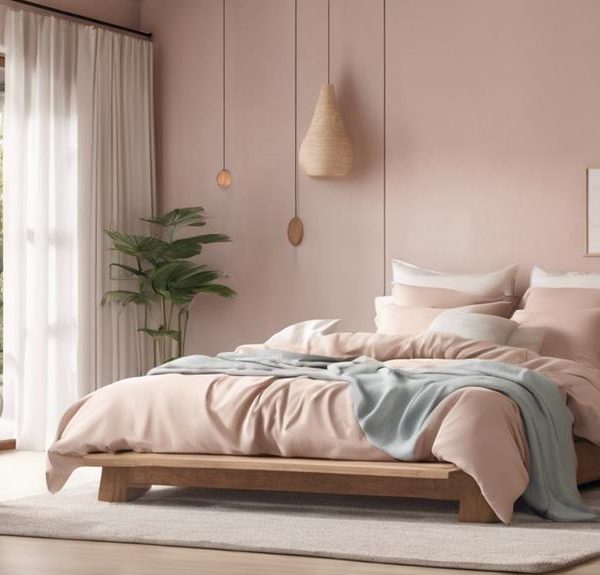

Sign up